19 ‘Up the Cap We Meandered’
The panoramas from the summit were crystal clear.
The friendly, imperfect refuge of Tahune Hut served Frenchmans parties well during the 1950s. Much of the atmosphere of that period, now long forgotten, comes to life upon turning the pages of the original hut logbook. Now mottled and fragile, these pages contain the reflective and candid jottings of a colourful parade of visitors to Frenchmans Cap during that interesting decade.189 Some parties enjoyed perfect weather, such as Alan and Maureen Richmond, who spent their honeymoon at Tahune Hut in April, 1950. Others, dogged by bad weather, bemoaned a bleak outlook from the hut door. Most remained cheerful and optimistic.
For some, though, the long trudge across ‘the Sodden Loddons’ was too much. ‘The going was much heavier than anticipated,’ wrote one dispirited party, ‘don’t think we will be coming this way again.’ In February, 1952, one visitor dutifully recorded the solemn news that ‘King George VI has died’, beside which another, less respectful observer quipped, ‘It must have been a hard trip.’ Some visitors passed the hours writing about their experiences on the track, or in composing doggerel.
We trod the sodden Loddon swamps,
We scaled the Barron heights,
The hail it flew, the wind it blew
And turned us grey with fright.
Others turned to more pragmatic verse:
It rained the first day, then the next, then two more after that,
Never again do I wish to see the Frenchmans bloody Cap.
Tahune Hut was a typical bush hut of the period: smoky, rustic and full of character. Dominating one end of the hut was the huge box fireplace, large enough to sit in. Around this, in every available inch of hanging space, were draped articles of steaming clothing, the inevitable casualties of a wet day on the track. Tahune Hut may have let in the elements, but it still was a haven for visitors sheltering from wild weather. A party from New South Wales captured the atmosphere of the hut around 1950.
Inside, we dropped our packs and gathered the damp firewood that had been left there by a previous party. Soon we had a smouldering, smoky fire going in the old rock fireplace and a cup of tea to revive our spirits. The wind blew through the cracks in the wall, the snow melted and ran in a watery stream down the chimney and the rain came in through a dozen holes in the roof. All the rest of that day we stayed in the hut waiting for the weather to break. Through the night we slept the sleep of exhausted men, warm in our feather-lined sleeping bags despite the dampness. The night became the day, and on and on the wind raged and the snow fell. The hut shook, and the deeper we dug into the ration bag.190
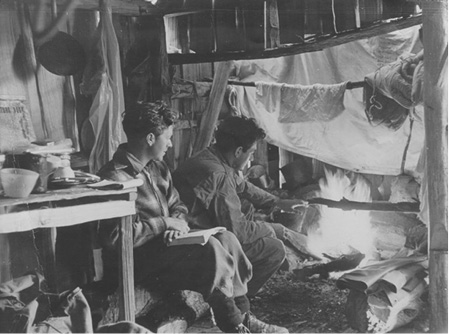
Inside old Tahune Hut. ‘Two Tasmanians’ – Tom Badcock (left) and Terry White, New Year’s Eve, 1952. (Tasmanian Archive and Heritage Office)
The bushwalkers of the 1950s and 1960s shared a camaraderie that differed in many respects from the present. ‘When you walked in Tasmania in those days everybody knew one another,’ David W. Wilson remembered.191 Days on the track and nights in the hut reflected a strong sense of community that marked the immediate post-war years. The legacy of two world wars and the Great Depression had impressed itself indelibly upon several generations of Australians. In the face of adversity, people stood shoulder to shoulder, cared for and respected one other.
This sense of fellowship also permeated the bushwalking community. ‘There is a small axe and dry wood hidden in a hollow tree about 25 yards back from the Frenchmans notice at Lake Vera,’ one thoughtful visitor wrote in the Tahune logbook. In later years, Terry Reid carried out the head of a broken axe, fitted a new haft in Queenstown and returned it to the start of the Frenchmans track, with a note attached requesting the next party to carry it in. The axe was duly returned to Tahune Hut.
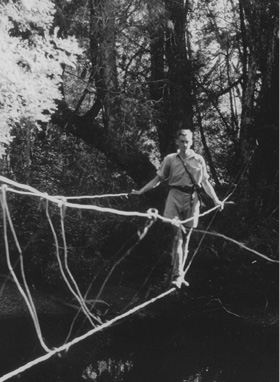
Loddon Crossing. Chris Binks negotiates a wire bridge over the Loddon River, January 1951. (David Pinkard)
Visitors to Tahune Hut
By 1953, Tahune Hut had received a hammering from the weather. Early that year, Assistant Superintendent Mollison and temporary ranger Glen Lamont walked into Frenchmans Cap to re-roof the badly leaking hut. Earlier, an Auster aircraft skilfully piloted by Lloyd Jones had dropped sheets of galvanized iron on the small plateau above Artichoke Valley, unofficially named ‘Flat-Iron Plateau’.
Mollison and Lamont successfully re-roofed Tahune Hut, but Mollison’s subsequent report on the state of the Frenchmans track was damning.192 He described the track around the shore of Lake Vera as ‘one of the worst it has been my misfortune to follow in Tasmania’, and, ‘The climb of 1100ft to Barron Pass is traversed on what can only be described as a second class wombat track. Artichoke Valley is a morass and I sank to mid-thigh in this area’, while the climb out of the valley was ‘typical of the steep and dangerous portions common on the track’.
Mollison summarised that Frenchmans Cap was ‘probably the most spectacular peak in Tasmania. However, only 504 walkers have visited the peak in the last three years, a testimony to bad tracks and lack of information.’
A few adventurous parties were making winter visits to Frenchmans Cap. One party spent a wild night at Tahune Hut in August 1953.
What a night! The wind came in great guns from the west at 10.30 p.m., and quite a few times we expected the hut to depart for Lake Vera. The gusts could be heard buffeting about in the crags, followed by a short lull, before they hit the wall of the hut with a bang and heavy rain lashed across the roof. Towards morning the rain turned to snow, and when we ventured to open the door we looked out upon a cold, white world. About nine inches fell here overnight. Tahune is one sheet of ice.
The location of Tahune Hut made it perfect for climbing the Cap and exploring other parts of the Main Range. A member of the Melbourne Walking Club even found time to sound the depth of Lake Nancy. ‘Greatest depth measured was 72 ft, though most of the lake is probably about 60 ft deep.’ Hobart walker and photographer Joe Picone spent a week exploring the region over the New Year of 1954, walking the rocky arc of the Main Range from Clytemnestra to Philps Peak.
A party from Adelaide recorded on 3 March 1955 that they climbed the Cap in perfect weather.193 ‘Late start today — could it have been the lullaby of the wavelets on Lake Tahune, or the warmth of our ‘Paddymade’ sleeping bags? Up the Cap we meandered, cameras loaded with colour film. The panoramas from the summit were crystal clear ... Beetled down the back of the Frenchman to take photos of Lake Nancy … Descended by usual route after climbing a gendarme on the way. The only disappointing incident of the day was discovered on arriving back at the cabin — the Kodachrome loaded in the Leica, at the summit, hadn’t engaged — the sequel is unprintable.’
At the end of the decade, Jock Turner, Vic Batchler, Paddy Pallin and Ken Brown spent six days at Frenchmans Cap. Describing themselves as ‘The Old Buffers Walking Club — ruthless, toothless, terrific, arthritic’, they gave no hint of their average age of nearly sixty years. The first two days of rain kept them confined to the hut. When the weather finally cleared, they made the obligatory ascent of the Cap. The next day they descended from North Col to Lake Gwendolen, then climbed the long ridge which rises up from the Franklin, over Mount Moore, and across to Clytemnestra.
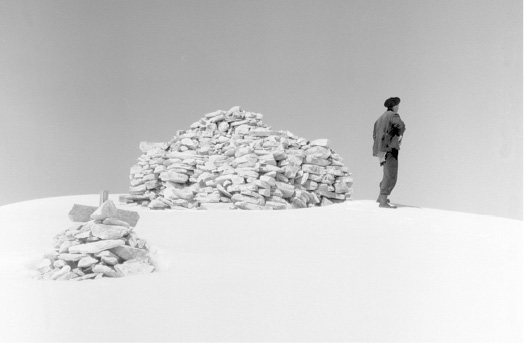
District forester Clarrie Murphy on the summit, August 1960. The small cairn containing the ashes of Ray Livingston can be seen in the foreground. (Jack Thwaites)
‘For the first time a helicopter landed on Frenchman’s Cap,’ reported the Mercury on 16 March, 1959. The object of the landing was to pick up two surveyors who had carried out an extensive survey of the area for the Lands and Surveys Department. ‘We reckon that’s cheating,’ suggested Paddy Pallin in an entry in the hut logbook. The next day the ‘Old Buffers’ left Tahune Hut, ‘making for Daverns Cavern, Vera and Philps Lead’.
From time to time, occasional parties of the more adventurous kind arrived at Tahune Hut from the west. On Christmas Day, 1960, a party of three intrepid Melbourne walkers left Kelly Basin on Macquarie Harbour. Four days later they camped beside Lake Gwendolen and next morning walked into Tahune Hut, happy and uncomplaining, ‘for our first rest day’.
A week later a party of Sydney Bushwalkers, including Dot Butler, arrived at Tahune Hut. Dot was one of a particularly energetic group of Sydney Bushwalkers known as ‘Tiger Walkers’ who had made a name for themselves in the years immediately before World War Two through feats of endurance. ‘Arrived from Lake Vera in 1¾ hours with 6-day packs,’ Dot recorded. ‘Hot, dry weather. Ashes from bushfires dropping from the sky. Sun like burnished copper seen through the smoke ... Leaving for Queenstown via Lake Gwendolen, creek to Franklin River and hydro-electric commission track to old railway.’
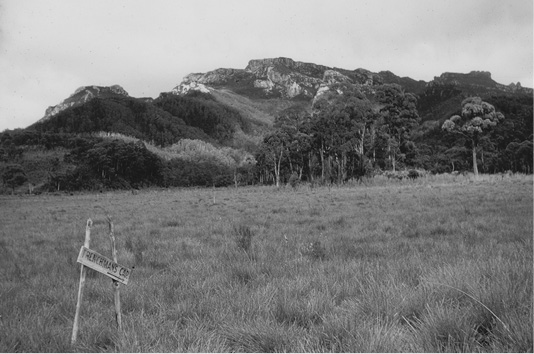
Philps Lead, 30 November 1958. The Main Range and the flat summit of Agamemnon dominate the skyline. (Rosemary Coupe)
In August, 1960, the SPB found itself in the unusual position of having limited funds available for trackwork at Frenchmans Cap. A new log crossing was placed over the Loddon River and the track across the Loddon Plains was re-routed to eliminate four unnecessary crossings of tributaries of the Loddon River. However, the task of fully repairing the ‘Sodden Loddons’ was out of the question. No serious track work would be carried out on the Frenchmans track for another 20 years. And it would be 50 years before the problem of the braided tracks, the head-high belts of tea tree, and the deep mud was finally addressed. In the meantime, ‘the Sodden Loddons’ would continue to frustrate walkers going into Frenchmans Cap.
Lake Marilyn
In June 1960, three members of the Tasmanian University Mountaineering Club spent two weeks camping at the head of Lake Vera. Jim Peterson was completing an honours degree in geomorphology, the study of the evolution and configuration of rocks and landforms. Jim had chosen to study the glaciation of the Frenchmans Cap region.
He was joined by his brother, Bill, and Jim Spinks. One task the party was keen to complete was an exploration of Lake Vera. For this purpose they carried in a tiny rubber boat to take soundings and map the bottom profile of the lake. The party also discovered a ‘new’ lake tucked away in the folds of the Main Range. This small, pretty lake is overlooked in spectacular fashion by steep slopes, crowned in turn by jagged peaks and rocky quartzite outcrops.
These slopes stretch down on all sides through dense forest to the lake shore. Fringing the shore are ancient stands of Huon pine, some of the most remote and untouched stands in Tasmania. They have survived numerous fires over the millennia due to their secluded aspect, altitude and secure microclimate.
Six months later, the party, including Peter Sands, returned to Lake Vera for three weeks and mapped the bottom profile of the ‘new’ lake. ‘Nights around the fire again turned to naming the remote lake,’ Jim Spinks remembered. ‘It was agreed that it had to be a female name in keeping with the other lakes in the area. Now it just so happened that I had met Marilyn Brunton, another first year student, five days before we left for the Frenchman. In fact we had gone out together the four nights before we left. Peter Sands knew Marilyn from high school in Devonport and I think strongly supported the proposal. Marilyn and I continued going out together for another four years before marrying. Peter Sands was best man. We have now been together for 50 years.’194 Jim Spinks and Peter Sands recommended the names ‘Lake Marilyn’ and ‘Vera Gorge’ to the Nomenclature Board of Tasmania, and the newly approved names were listed in the Government Gazette of 14 August 1963.195
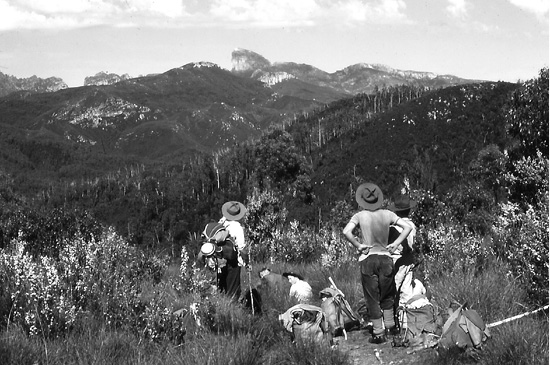
On Mount Mullens. Members of the Launceston Scout Troop, January,1963. (David Harvey)